
4 minute read
Origins of Macaron
from ALFEREZ S.T.E.M. 17 - etech
by shmae
The Franco-Italian Queen Catherine de Medicis
Most food historians agree that the macaron–or at least the recipe that inspired the French version of it, was likely brought to France by the Italian-born Queen Catherine de Medici during the early 16th century.
Advertisement
Where does the French Macaron came from?
It's believed that themacaroncookie was born in Italy and brought over to France as early as 1533 by Catherine di Medici, a noblewoman from Florence who married the future King of France, Henri II. The firstmacarons werevery simple cookies made of sugar, almond flour and egg whites.
Some of the first macarons in France were baked by a group of nuns in St-Emilion. The recipe is passed down through generations. A shop in the fortified medieval town of SaintEmilion called Fabrique De Macarons, is known to make the original recipe of macarons.
The woman who owns the bakery inherited their ancestral recipe, passed down from the 17th century.
There are many recipes from around France–But which is the original?

The shop-front at Véritables Macarons de Saint-Emilion, Nadia Fermgier. Image credit: EMCD

A 1904 illustration of the Macaron of Nancy (Published in the Dictionnaire encyclopédique de l’épicerie et des industries annexes by Albert Seigneurie). Wikimedia Commons
While Saint-Emilion often claims to hold the recipe for the “original” macaron, numerous versions of the airy confections are produced to this day around France. 2
Melding the qualities of a small cake and a cookie or biscuit and invariably made with egg whites, sugar and ground almonds, each iteration of the macaron is a proud tradition in several French cities and regions.
These include St-Jean de Luz in Basque Country, Nancy, Amiens, Chartres, Boulay and Cormery. And that’s not even the whole list.
All of these versions consist of a single cake or biscuit, rather than the two-pressedtogether we’ve become accustomed to seeing.
Basque Macaron. Image Credit: Cuisine De Rieve

17th-century Ursuline nuns from St. Emilion baked slightly rounded, rough disks pressed into paper sheets and sold in a single, simple flavor.
These days, at the Fabrique de Macarons run by Nadia Fermigier, each macaron is neatly pressed onto an individual square of corrugated paper, so it’s easy to tear off one or two to share or pack, without the risk of them instantly crumbling.

French Basque-style macarons from the Maison Adam in Saint Jean de Luz. Image: Travelcookeat.com
In many of these towns, family bakeries claim to have inherited the rights to the “original” French macaron recipe–or at least to the one from their own town.
But such assertions are nearly impossible to verify, and arguably irrelevant since macarons probably originated in Italy.
In the remarkable diversity of the French macaron and its centuries-long history: only one version has won global recognition as the “default”–and it’s the most recent one.
It was only from the 1830s that the “modern” macaron first appeared in France, ostensibly invented by a baker named Pierre Desfontaines. Jams, liqueurs and spices initially served as fillings.
In the 19th century, buttercream, jam or even applesauce filled two biscuits pressed gently together. Interestingly, such versions reportedly first popped up at bakeries inParis’ working-class Belleville district–seemingly tacking away from the macaron’s royal and religious associations.

In the late 19th century, a Parisian teahouse called Pons began selling their own version of the filled macaron; the teahouse would later be renamed as alpatissier. Dalloyau, after the roy
Special-edition macarons from Dalloyau.
Taken with tea in opulent settings, the reinvented macaron became one such product favored by the well-to-do.

It wasn’t until 1862 that the Maison Ladurée opened its doors in Paris, with a first tearoom and bakery at 16, Rue Royale. From the outset, Ladurée positioned themselves as catering to a new Parisian bourgeoisie, eager to show off their wealth by consuming a variety of luxury products.
The macarons that won the race are gleaming, efficiently marketed products of modernity and globalization. They’ve effectively crowded out traditional predecessors.
Laduréereportedly boasts revenues exceeding $1 billion, and has nearly as many retail shops in Asia and the Middle East as it does in Europe.
On the more artisanal side of the coin, pastry chefs such asPierre Hermé, who was awarded the title of World's Best Pastry Chef in 2016 by the World's 50 Best Restaurants andJean-Paul Hevin, French manufacturer of high-end chocolate, have reimagined the humble nunnery cakes as elaborate gourmet creations, infusing them with everything from black sesame and foie gras to fig and wasabi.
There are numerous variations of macarons created in many different places, and each of the popular variations has enticed people because of the dessert.




